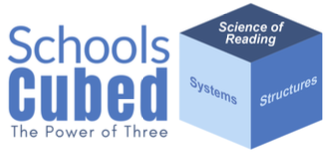Our consultants provide professional development geared towards your schools needs. The following are available topics for secondary education.
Systems, Structures and the Science of Reading are the key ingredients in all highly-performing schools.
Strong SYSTEMS ensure effective collaboration and give teachers the data they need to measure progress and performance.
Successful schools have STRUCTURES place to ensure school days are learning-focused and maximize instructional time.
High-performing schools know and use instructional strategies based on the SCIENCE OF READING to achieve exceptionally high outcomes for students.
Contact us
Contact Schools Cubed:
303.549.8676
www.schoolscubed.com
School leadership is second to teaching among school-related factors in its impact on student learning, according to research.
Moreover, principals strongly shape the conditions for high-quality teaching and are the prime factor in determining whether teachers stay in high-needs schools. High-quality principals, therefore, are vital to the effectiveness of our nation’s public schools, especially those serving the children with the fewest advantages in life. (Wallace Found).
Participants will learn the basis of the learning process and what can hinder a student’s ability to learn. Also discussed are high-leverage instructional strategies including explicit instruction, how to design and deliver a lesson, and increase motivation and engagement with students.
Many students dropout and/or become frustrated with school because of their lack of ability to read grade level content material. Raising literacy levels of students at the secondary level is complex and requires all teachers engage in increasing literacy outcomes. Many secondary teachers feel ill-equipped to know what strategies increase students’ literacy levels. This course is intended for all discipline/content teachers and administrators and provides an overview of what ALL teachers can do to increase students’ reading abilities without leaving the content behind.
At the secondary level, most content is taught through “units.” Lesson planning, aligning standards, learning targets and data analysis can all be embedded into a unit plan. This session walks teachers, instructional coaches, and administrators through building of unit plans and linking them to the school’s assessment system so that continual monitoring of growth is assured for all students.
As many secondary teachers would say, students just seem to lack engagement and motivation including non-struggling readers. Motivation and engagement are often considered intrinsic in nature, but there are many factors that can enhance student interest in the various disciplines. This session offers strategies and tips to teachers in every content.
Raising the literacy levels of students at the secondary level includes not only ensuring content/discipline teachers know what strategies to use, it also includes infrastructural changes within the school. Examples include:
To increase literacy levels at all grade levels, it is imperative that secondary schools use the correct assessments and have a comprehensive assessment system in place. Choosing the correct assessments that not only monitor literacy levels of students, but also measure content standards, may sound like a daunting task, but in many cases is more simple than what a school is already using. This professional development session explains what we should be assessing, why we should assess it, and provides examples of appropriate assessments to consider. Screening tools, progress monitoring, diagnostic assessment, and benchmark assessments towards the standards are all covered.
How much a student “practices” reading by simply reading is the best remedy for disfluent readers, yet struggling readers are the least apt students to read, creating a chasm between struggling readers and proficient readers. Disfluent readers need to hear good readers and they need to be guided through important passages of text to help them comprehend. At the end of this session, teachers will understand basic fluency strategies they can use in any content area to help increase students’ fluency abilities.
Vocabulary knowledge can have a significant impact on both reading comprehension and fluency at the secondary levels. Vocabulary instruction in the content areas should not only increase the number of words a student knows, but also the depth of understanding of these words. This professional development session will offer various vocabulary strategies that all content teachers can use that enhance students ability to comprehend text and develop a rich vocabulary.
Linking formative assessments to learning targets or goals gives teachers a clear understanding on not only on how students are progressing toward the goal/standard, but also how it can improve a teacher’s instruction. When linking formative assessments with Unit Planning, teachers have the ability to differentiate instruction and provide necessary scaffolds to ensure success for more students.
